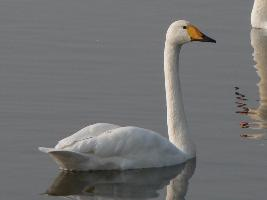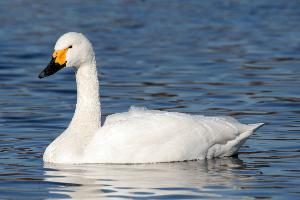
Poids et mesures
| Longueur | de 75 à 90 cm |
|---|---|
| Poids | de 2 à 4 kg |
| Envergure des ailes | de 147 à 180 cm |
Données biologiques
| Durée de vie | 20 r |
|---|
Statut de conservation
| Intrépide |
Description de l'animal
The Greylag goose (Anser anser) is a large and impressive bird that holds the distinction of being the ancestor of most domesticated geese breeds. Native to Europe and Asia, it is the largest and bulkiest of the grey geese, easily recognizable by its distinctive features and behaviors.Physically, the Greylag goose is robust with a body length ranging from 74 to 91 centimeters and a wingspan that can extend up to 160 centimeters, making it a formidable presence in its natural habitat. The plumage of this bird is predominantly grey, with subtle variations in shade that can range from light grey to a darker, almost slate grey. Its feathers are edged with white, which can give the bird a somewhat speckled appearance, particularly noticeable on the back and wings. The belly is lighter, often presenting a nearly white coloration that contrasts with the darker back. One of its most striking features is its beak, which is large, robust, and pinkish-orange, matching the legs and feet in color, creating a striking contrast against its grey plumage.
The Greylag goose's eyes are alert and bright, with an intelligent expression. Its head is relatively large with a broad forehead, and the neck is thick and long, enabling it to forage in deeper waters. The bird's call is a loud, honking sound, which is characteristic of geese and can be heard over long distances, particularly during their migratory flights or when they feel threatened.
Greylag geese are highly social animals, often found in large flocks, especially during migration and in their wintering grounds. They show remarkable fidelity to their nesting sites, with pairs returning to the same location year after year to breed. Their nests are substantial structures built on the ground, hidden among reeds or in dense vegetation to protect them from predators. The female lays 4 to 6 eggs, which she incubates for about four weeks while being guarded by the male. The goslings are precocial, meaning they are relatively mature and mobile from the moment of hatching.
Their diet is varied and includes grasses, roots, seeds, and aquatic plants. They are known to graze in fields and meadows, often causing them to come into conflict with farmers due to their appetite for crops. In some regions, Greylag geese have adapted to urban environments, feeding in parks and gardens, where they can become quite tame and approachable.
Migration is a significant part of the Greylag goose's life cycle. Populations breeding in the colder northern regions migrate southward to spend the winter in warmer climates. Their migratory journeys are impressive, with flocks flying in V-formations that are not only a marvel of natural coordination but also serve to conserve energy, allowing the birds to cover long distances.
The Greylag goose plays an essential role in its ecosystem. As a grazer, it helps control the vegetation in its habitat, and its nesting habits contribute to the structure and diversity of wetlands. Despite facing threats from habitat loss, hunting, and pollution, the Greylag goose remains widespread and is not currently considered endangered.
In summary, the Greylag goose is a fascinating and adaptable bird, embodying the wildness of the natural world while also displaying an incredible ability to coexist in human-altered landscapes. Its social behavior, migratory patterns, and distinctive appearance make it an iconic species of the wetlands and open fields of Europe and Asia.
Animaux similaires
Nouvelles photos d'animaux
Top 10 des animaux
- Dolphin gull (Leucophaeus scoresbii)
- Diana monkey (Cercopithecus diana)
- Moustached guenon (Cercopithecus cephus)
- Galápagos tortoise (Geochelone nigra complex)
- Japanese macaque (Macaca fuscata)
- Stone loach (Barbatula barbatula)
- Russian tortoise (Testudo horsfieldii)
- Greek tortoise (Testudo graeca)
- Common flying dragon (Draco volans)
- Vendace (Coregonus albula)


